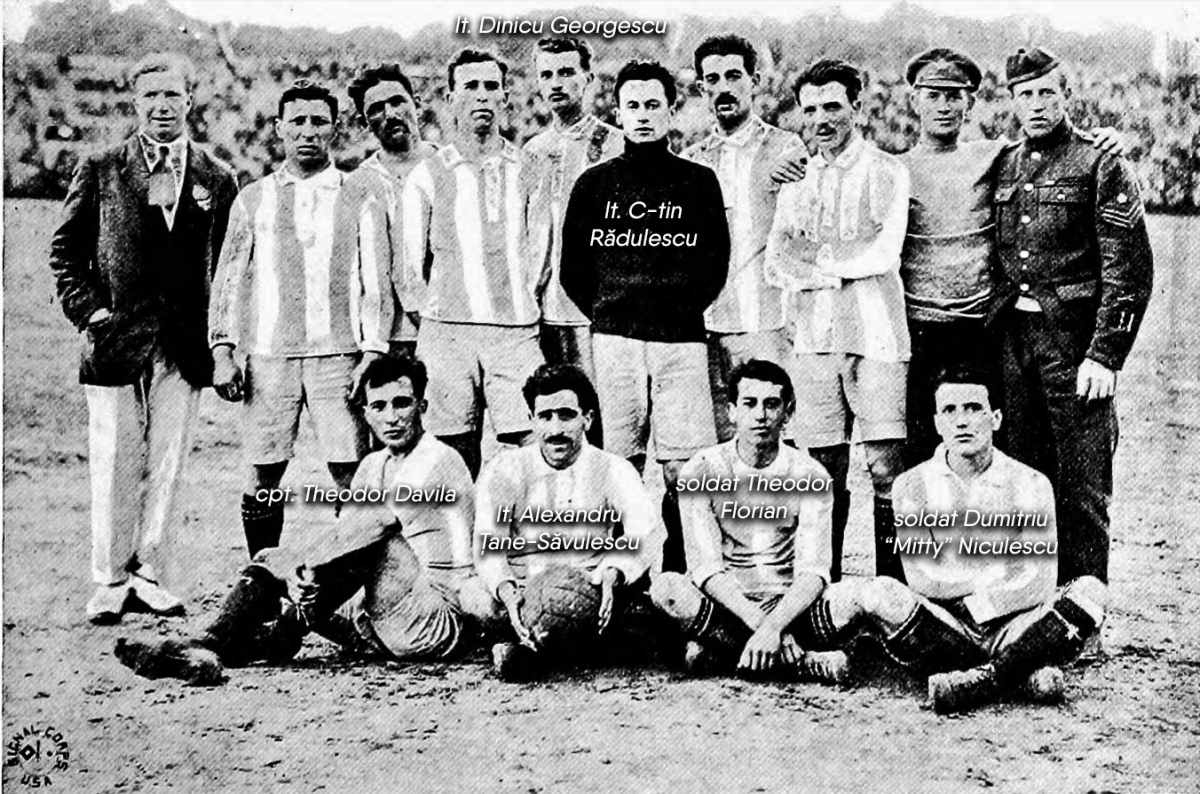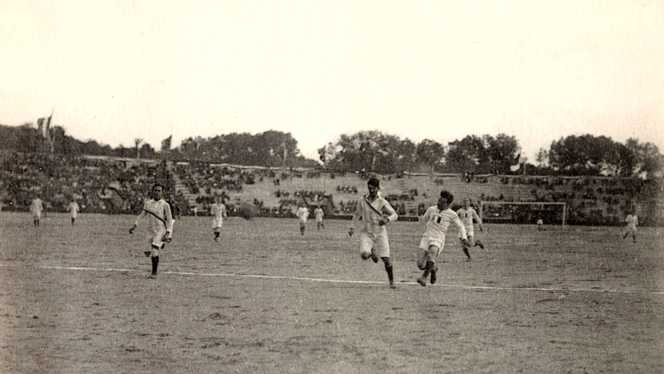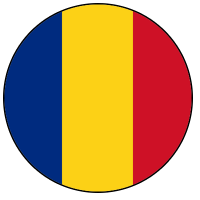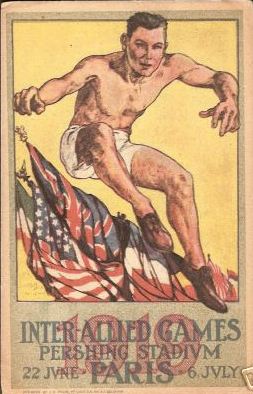Thanks to Brian D. Bunk of the excellent soccerhistoryusa.org website for drawing my attention to this multi-sport competition, held a hundred years ago, after the cessation of hostilities on the western front. Romania was one of eight countries which sent a team to take part in the football tournament. Although the composition of the team was entirely different from the squads that would line up for the country’s first official internationals in 1922, there are some fascinating stories connected with the characters who took the field at the Pershing Stadium in Paris in the early summer of 1919. I’d welcome any further information readers are able to provide about the Romanian participants.
In June 1919, just a couple of weeks after the peace negotiations had confirmed that Romania would get to keep Transylvania, Banat and Crișana, Paris hosted the Inter-Allied Games. This was a sporting competition to which were invited teams of servicemen from all the countries who had been on the winning side in the war – though the competitors had to pay their own travel and board. The event would be held in the Pershing Stadium, a gift to France from the American people. Eight teams would contest the football tournament.
The Romania football team at the Games was drawn almost exclusively from Bucharest, and no ethnic Hungarians were involved. (In the tradition of early football in the capital, it did, however, include a German and an Englishman.) The Romanian army still had 60,000 men under arms on the Tisza front, at war with Hungary. Most of the participants in these Games would afterwards be sent there to fight again.
Several of the team were important figures in early Bucharest football; others would play a role in bigger footballing events in the future. The full list of competitors (riddled with typos / idiosyncratic spellings) is here.

Rădulescu was both player and secretary of the Olympia club. Capt. Theodor Davila, the thirty-year-old scion of a very distinguished family, had played for Olympia before the war, winning the title in 1910 and 1911. As vice-president of the FRF in the 1930s, Davila would argue against the nationalist 8+3 selection system of player selection, intended to promote ethnic Romanians in the national team at the expense of ethnic minorities. He died at Odessa in 1941.
Lt. Țane Săvulescu would later be on the staff with Rădulescu at two World Cups; in 1938 his team selection would be blamed for the country’s humiliating exit at the hands of Cuba. Private Dumitriu “Mitty” Niculescu was the leading light of the Venus București club, which he had helped to found in 1915 and which he would guide to great success in the 1920s and 1930s as player and administrator. The Englishman was Ernest Hillard, a Shell oil man in his early twenties, with no military rank given beside his name in the register. He would line up alongside his team-mates from these Games, Rădulescu and Lt. Constantin “Dinicu” Georgescu, in the Tricolor București team that would win the Romanian title in 1921, the last year before the championship was opened up beyond the Old Kingdom.
After that time, clubs from the former Hungarian territories, awarded to Romania at the Paris peace negotiations of 1919, instantly dominated the newly-enlarged nation’s football scene. The Romanian national team, which played its first official fixture in 1922 (read the whole fascinating story here), in contrast with the representatives at the Inter-Allied Games, consisted predominantly of Germans, Jews and Hungarians from these territories. Thus, the only member of this 1919 team who would go on to play in an official match for Romania was Theodor Florian. He did so once, in 1923, against Turkey – a strange match, but that’s a whole ‘nother story.* Incidentally, Florian was also part of the Romanian rugby team that won bronze at the 1924 Olympics by finishing third out of three.
Lt. Gheorghe Țicleanu played in both the football and rugby teams at the Games. Among the participants in other sports at the Pershing were 2nd Lt. George Vraca (rugby), who would go on to find great fame as an actor – he had also played football for Olympia before the war; and 2nd Lt. Virgil Economu (swimming), who would wield lasting influence as a football coach, tactician and theorist.
Economu would stay on in France until 1923, studying agronomy, swimming, playing rugby, and training the Montpellier university football team. Back in Romania, he set up a referee school, ran a couple of newspapers, coached Tricolor Bucuresti and Gloria Arad with considerable success, opened a coaching school, and then served as national team coach and president of the FRF. In the 1950s, as technical director of the army’s CCA club (later renamed Steaua), Economu developed what he considered a specially Romanian style of play. His assistant at CCA was Angelo Niculescu, who would coach Romania to (and at) the 1970 World Cup. A young player at the club at the time was Emeric Jenei, who would oversee Steaua’s European Cup triumph in 1986 and coach Romania to qualification for their next World Cup in 1990. The thread thus runs through from Economu to Jenei’s own assistant Anghel Iordanescu, who coached Romania at the 1994 and 1998 World Cups and Euro 2016. Florin Faje wrote an excellent article in English about Economu and his Romanian style, which you can read here.

The Hungarian-Romanian War ended in August, when Romanian troops took Budapest. When Lt. Eugen Mețianu, another member of the football team at the Games, was demobbed and went home to Cluj in the autumn, he got together with his old school friends and helped to start a new football club, Universitatea Cluj.
Possibly interesting note: this competition at the Pershing stadium was the first time Romania played an international rugby match. Nowadays, whenever Romania face the USA at rugby, they are playing for the Pershing Cup.
The rest of the football squad, about whom I know next to nothing:
- Alvirescu, Constantin (Lt.) – involved with the foreigner-dominated pre-war clubs Bukarester and Romano-Americana.
- Ginița, Vasile (Lt.)
- Maiorescu, Dumitru (S. Lt.)
- Mareș, Savu (Lt.)
- Roman, Horia (Capt.) – played for Olympia
- Sacăreanu, Nicolae – played as a defender for Colțea București
- Buțu, Trăian (Lt.) – played up front for Colțea București
Sgt. Rudolf Schmettau, who was apparently the German mentioned above, is listed only for rugby in the register of competitors; however, he was certainly part of the football team.
*The Romanian sports federation was invited to send its national team for Turkey’s first ever international match, to celebrate the proclamation of the new Republic, in late October 1923. On 21 October, 30 players and 5 officials boarded the boat at Constanța. The party included a Bucharest XI which would play against local teams: Dinicu Georgescu and Mitty Niculescu were in this side. Costel Rădulescu was among the party too, as coach of Romania and representative of the Bucharest FA.
Mario Gebauer, chief of the federation’s football committee, had decided not to pick players from the big clubs of Transylvania and the Banat, as these had refused to travel if they were not paid. This meant taking a severely weakened side to Istanbul. Venus defender Theodor Florian was joined in the Romania team by a smattering of other players based in the capital, while Brașov and Târgu Mureș were also represented. There was, apparently, one fully professional player in the team, Isidor Gansl, an Austrian Jew who had joined Maccabi in the (formerly Austrian) city of Cernăuți.
The game was played at the Taksi Stadium in Beyoglu (where Gezi Park now stands), in front of 7,500 spectators. The Turkish coach was Ali Sami Yen , founder and first president of the Galatasaray Football Club in 1905. The match finished 2-2, Gansl scoring both the visitors’ goals. Only one of the team – Leopold Tritsch – would ever play for Romania again, and he did so only once, the following year.
But I digress.
Sources
On the 1919 Inter-allied Games:
- https://lastegaru.net/2018/03/19/fotbalistii-romani-in-cele-doua-razboaie-mondiale-ep-1-cei-ce-au-facut-unirea/
- https://soccerhistoryusa.org/episode-notes/the-inter-allied-games-top-stars/
- https://archive.org/details/cu31924014114353/page/n511
On the 1923 Turkey v Romania match:
On Ernest Hillard:






Leave a comment